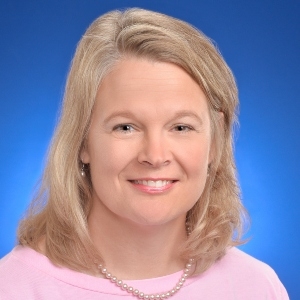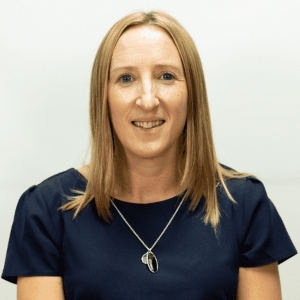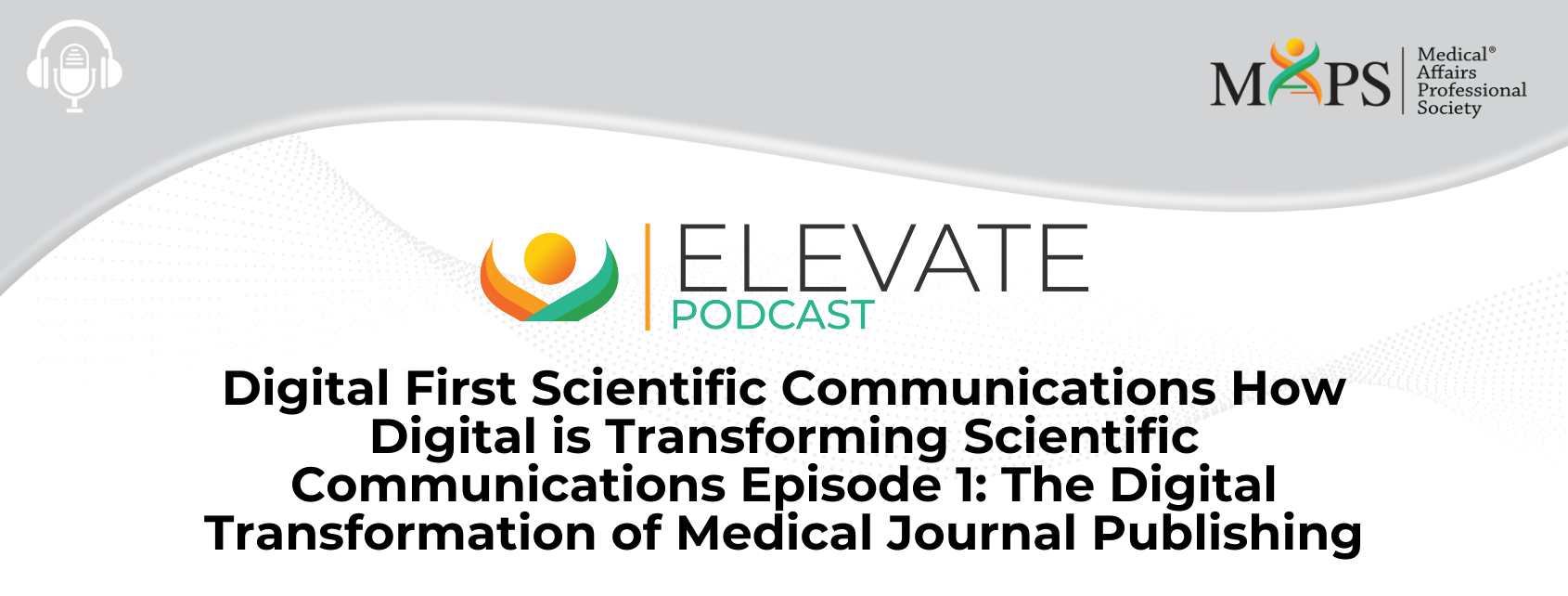Digital First Scientific Communications – How digital is transforming scientific communications
EPISODE 1 – The Digital Transformation of Medical Journal Publishing
This podcast series will focus on how digital is transforming scientific communications.
Episode 1 will focus on the journal publishing industry, discussing how medical journal publishing is changing and what changes we might see in the future.

CO-MODERATOR: Jennifer Riggins, PharmD

CO-MODERATOR: Steve Casey

INTERVIEWEE: Joanne Walker
Following is an automated transcription provided by otter.ai. Please excuse inaccuracies.
Jennifer Riggins 00:00
Welcome to the Medical Affairs Professional Society’s, Digital Focus Area Working Group’s Podcast Series: Digital First Scientific Communications, How Digital is Transforming Medical Communications. In our podcasts, we will speak with experts in the field of scientific communications, and discuss how the digital transformation of medical publishing is opening opportunities for medical communicators. We hope you enjoyed the series. In this first podcast episode, we will be discussing the digital transformation of medical journal publishing. I’m Jennifer Riggins. I’ll be the moderator for today’s podcast. I currently serve as a member of the Digital Focus Area Working Group. I worked at Eli Lilly and Company for 28 years with a focus on medical information, scientific communications, and medical digital. I am joined by Steve Casey of Omni Healthcare Communications, a leader in digitally optimized medical communications. This podcast series follows on to the Elevate article, “Audience Amplification and Digital Scientific Exchange” and the MAPS Audience Amplification Webinar, which was held in February 2021.
Steve Casey 01:17
The views expressed in the recording are those of the individuals and do not necessarily reflect on the opinions of MAPS, or the companies with which they are affiliated. This presentation is for informational purposes only, and is not intended as legal or regulatory advice.
Jennifer Riggins 01:35
We encourage you to engage in conversations about audience amplification, and the digital first medical communications with other MAPS members via MAPS Connect on the MAPS website or mobile app. Simply log in with the email address and password associated with your MAPS account and access the global community. Then click on the discuss tab and scroll down to digital to post a question or to review previous postings. Our podcast objectives are for listeners to better understand how and why medical publishing is changing and where is it going in the future. The benefits of solid publication selection and how enhanced publication content can improve publication access. Today, we will be discussing the evolution of medical publishing with Joanne Walker. Joanne is the Head of Publishing Solutions for the Future Science Group. Welcome Joanne. It’s so nice. You could join us today. Can you give us a brief background of your career and the responsibilities of your current position?
Joanne Walker 02:44
Thanks, Jennifer and for inviting me to share my thoughts and experiences today. I’ve been in medical publishing for over 20 years now. I started my career as a journal editor commissioning journal content for the expert opinion journals. Since then, I’ve worked across several journal portfolios within the Future Science Group. As you mentioned, I’m now head of publishing solutions at FSG. My role really has developed in tandem with the digitization of medical publishing. I develop new types of digital enhancements alongside our articles, and I work with medcomms and pharma pubs planners, as well as other authors to ensure they are aware of all the digital options we offer. I also try to make sure their experience with that really goes well so that they can submit to us again.
Steve Casey 03:30
Joanne, it’s great to speak with you today. We’ve done a webinar for MAPS and written a couple of articles as well. But they all have been from the sponsor and author perspective. I’m very interested to hear the publishers perspective on the digital transformation of scientific publishing. Could you give us an idea of some of the different enhanced publication content that future science group is making available to authors?
Joanne Walker 03:53
Yeah, thanks, Steve. Yeah, so at FSG, we’ve really embraced featuring enhanced publication alongside our articles. We’re a small publisher, which means that we can be agile and try new things without facing any bureaucracy that you might see within a bigger Publishing Group. Our journals are published on a great platform which is hosted by Atypon and it gives us options to try out new things. We’re always looking to try new initiatives and our IT team really have learned to read my How can we do this emails that I send quite regularly. So, we really do encourage authors to augment any publication with digital enhancements from the start, and our options are mentioned within the author guidelines. Features we can publish include graphical abstracts, infographics, videos, podcasts, plain language summaries, so if you name it, I’m pretty sure we could do it. They’re all published either within or alongside the article in front of any paywall. This means that even if the author isn’t choosing to make their article open access, readers can view the digital enhancement. Alongside our journals we also have several platforms where we’re able to enhance publications further. So, for instance, we have the Video Journal of Biomedicine, which is the platform for publishing peer reviewed videos. Each video is assigned a DOI making it citable in its own right. So, any author who wants to create a video discussing their article can also choose to co publish the Video of Journal of Biomedicine, which then extends the reach of the video and also makes it independently citable. So, what’s unique about this platform is we also publish videos from authors discussing any journal article, not just published by FSG. So, if authors wants to do a video, but have published in a journal that doesn’t offer digital enhancements, and you know, unfortunately, there are quite a few out there that still don’t offer these, they can use the video journal of biomedicine to host their video. We also have an in house video team. So, we can offer sort of a whole end to end process of recording production, as well as sort of publishing videos. We also have several digital websites or digital hubs as we call them, which are published alongside several of our journals. So, for instance, our journal Future Oncology is associated with the site Oncology Central. Again, authors can feature their article on the hub as a means to extend the reach of their article to the audience of the website. We’re also developing a new feature on our hubs connected with published articles. We call these publications in focus, which feature a collection of several digital enhancements on an article. So, for instance, an author might have a podcast discussing the article and infographic and a video explaining the results in more detail. These are published on a dedicated page on the hub, and shared to all our audiences or by email, social media, etc. You know, we recognize that some people are visual learners and like to listen and learn. So, we really think offering these digital enhancements is a great way for authors to help people understand their work.
Jennifer Riggins 06:54
I really love hearing about all these different ways we can make information accessible and available. You know, I think it’s really super exciting. However, often in biopharma Medical Affairs organizations, the enhancement of publication as an afterthought, could you speak to what you see as the benefit of enhanced publication content to authors and sponsors?
Joanne Walker 07:17
Yeah, that’s a good question. Um, so. So, nowadays, authors really do need to consider tools that make a publication stand out from the crowd. So, planning for digital content should be considered, you know, really alongside the development of publication, you know, perhaps even starting with the abstract. So, even for authors who do not have access to resource, it is quite easy these days to make a video on a mobile phone or create a simple infographic in PowerPoint. We’re all now used to watch you know, videos recorded via web platforms like soon and it really is easier than people think, to create a video. So, I mean, in terms of the benefit enhanced publications, for me, there are two factors of time and accessibility. You know, we all know that HCPs and researchers are more time constrained than ever. So, having a publication explains to an infographic or videos helps readers learn about a publication in a way that’s really easy for them. And any digital content can also be used as tools to share with other researchers or readers to make them aware of the publication. So, they’re also great for sharing on social media, like where, you know, where many researchers, you know, so discovering content, beyond like more traditional places like PubMed.
Steve Casey 08:23
You know, I’m sure you’re always reviewing the publishing market and learning what’s being offered by other scientific journals. Can you give us some idea of what you’ve seen, and those enhanced publication content opportunities that you believe can be assisted in, in engaging readers and those offerings that don’t seem to have any benefit?
Joanne Walker 08:42
Um, yeah, so I mean, as publishers, we all, you know, we always need to sort of see what others are doing. And, you know, there really are some good initiatives out there. I mean, the NEJM quick tech videos are, you know, simple, but so eye catching, and, you know, BMJ have also created some engaging infographics, you know, publishers like Adis, Sage and Taylor & Francis , you know, have a great portfolio of digital enhancements like us. And we know can create some fantastic engaging content. So, for the second part of your question, I’m not sure I’ve come across anything that I really dislike. However, what does frustrate me is those publishers and journals that do not offer the options to feature digital content, you know, they’re really missing out on an easy way to engage and even help their readers. So, having the options to feature digital content, should perhaps, you know, really be one of the factors that authors should consider, you know, when choosing a journal, where they should publish.
Steve Casey 09:37
So true, I believe that journal publishers and Congress associations are just really at the front edge of using digital to engage audiences and enhance publications as the head of publishing solutions. What do you think the future holds for enhanced publication content?
Joanne Walker 09:52
Yeah, so um, yeah, so as I, as I mentioned, you know, first we really do need to get all publishers embracing it enhance publication. You know, I beyond that I think the future is really exciting, you know, especially as more and more technologies are developed to allow for much easier, you know, accessible content, you know, so for instance, we’ve just launched a new e reader on our website, which provides a more interactive experience for our readers, you know, instead of them reading the static PDF, you know, this also helps journal articles be more accessible to digital content, and can be, you know, so uncovered, read using sort of assistive devices such as screen readers and touchscreens. And in the future, I’m sure technologies can also provide more or, you know, really more interactive reading experiences. So, you know, you could have a mechanism of action video pop up and play automatically within a publication. Or you can have an author read aloud a publication, as you sort of scrolls through the article, you know, the options really could be endless. I think.
Jennifer Riggins 10:48
So and you’ve mentioned a lot about enhanced publication content making content accessible. Could we take a moment and drill down a little bit on plain language summaries? As I think our listeners would really appreciate this? plain language summaries seem to be something that many sponsors are trying to determine how to use. Do you have any insights on best practices for the use of plain language summaries?
Joanne Walker 11:13
Oh, gosh, I could talk about plain language summaries pls all day. You know, these really are a passion of mine, you know, as they make journal publications and scientific research accessible. As far as we know. FSG is the first publisher to be publishing standalone pls. And as you can imagine, we’ve received a lot of interest in this. So, the pls that we publish are peer reviewed, and published open access in a journal like a normal journal article. But you know, unlike a normal journal articles, PLS are written in plain language and laid out using graphics and images. So, you know, lay friendly and easy to read. And by publishing, you know, pls of journal articles, it also means the pls discoverable, discoverable. And we’re seeing these articles are, you know, becoming really very well read. So, in terms of best practices, I think sponsors really need to figure out what they want to achieve with pls then develop a process and including patients in developing this process is key. And their feedback is often invaluable. So, things to consider are, you know, which publication do you choose to make a PLS? Not all publications could be of interest to patients, you know, but then it’s selecting certain publications, also cherry picking, you know, where should these be published? So, some pub sponsors publish pls on their own website, but then would patients be able to find these pls? And then trust the content? If it’s on sponsors’, which website? You know, and is publishing pls on the sponsors, website, direct patient marketing, so you know, legal and compliance may have, you know, their own thoughts on this? You know, there’s so many sort of when which and how factors, you know, to consider. I do really think we’re, you know, we’re so we’re at the start of this whole pls initiative, and any sponsors started to think about pls should look at what others are doing. So, for instance, Pfizer have a great policy for pls. And have already published several pls with us. ISMPP as well have released some insights in a new article that was published in CMRO earlier this month, and I’m sure there’ll be offering more guidance in the, you know, the GPP guidelines and beyond. So, you know, it’s definitely a case of you know, watch the space with regard to PLS.
Jennifer Riggins 13:23
Yes, for sure. Thank you. And thank you, Joanne. Steven, I want to thank you for joining us today and answering our questions. I know that there is an enormous amount more that we could cover. And perhaps we will have a follow up episode in the future to deliver deeper into this publishers’ perspective and what is available today and what the future holds. But until then, this has been Jennifer Riggins, and Steve Casey, bringing you the first episode in our series digital first scientific communications, a podcast production of the digital focus area working groups of the Medical Affairs Professional Society.
Steve Casey 14:04
If you’re a MAPS member, thank you for your support of MAPS. And if you’re not yet a MAPS member and would like to access additional resources in this area, please visit the MAPS website to explore joining today at Medical Affairs.org backslash membership. And this concludes the podcast






